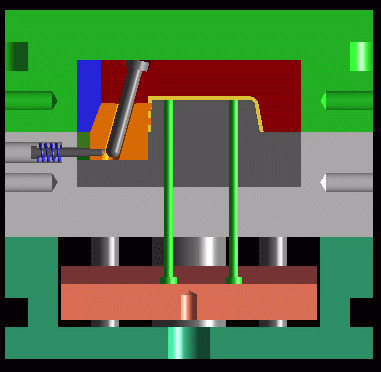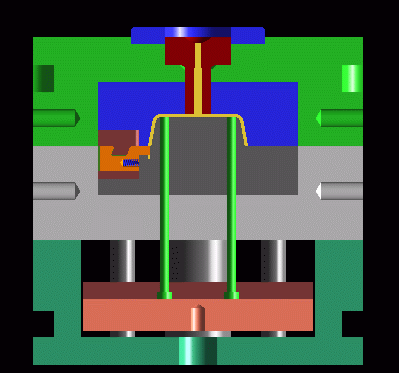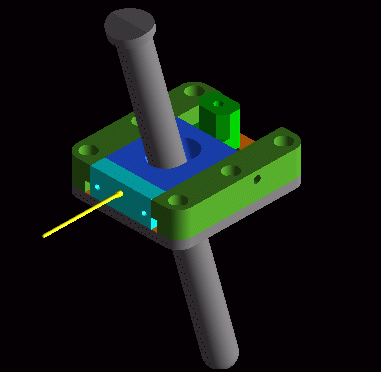

SLIDES
Slides are usually used for relieving external undercuts or to allow for zero degree draft on part exteriors. Their motion can be driven by one of several mechanisms. Any slide mechanism must also employ a locking device to hold the slide against the ravages of molding pressures in excess of 10,000 psi.
Slides may generally be categorized by their driving mechanisms.

Known as a cam pin, angle pin, horn pin, etc., this is the most common and versatile of all slide mechanisms. It is driven by the opening of the press. The action of the angled pin withdrawing from the angled hole drives the slide back. Springs hold the slide in the retracted position. Upon press closing the cam pin returns to drive the waiting slide back almost to molding position. Finally then the lock seats against the back of the slide, driving it to its home position and clamping it there for the duration of the next shot.

Similar to the cam pin slide in principle, the cam actuated slide is limited to strokes of about 0.080 in. The cam slide is good for relieving very small localized undercuts such as one word of raised text on the side of a product or a few small holes. Instead of using a pin it simply has a metal cam that also incorporates a lock.
Hydraulic slides are frequently used when pecker pins won't work for some reason. For example very tall slides must be pulled hydraulically because pecker pins exert too much torque on the slide gibs and may cause binding. Locks are still incorporated in the same manner as in a pecker pin slide. Shown is an example of hydraulic slides as used in the Silicon Graphics O2 top case tool.
Locking hydraulic cylinders are used when undercuts occur in the cavity side of the tool. This is a situation that the savvy part designer will avoid if at all possible. Locking cylinders have a self contained locking mechanism that helps the cylinder hold against molding pressure. They are rated by pounds of holding pressure. This is calculated by multiplying the projected molding area on the slide by 10,000 psi.
Spring actuated slide
Spring slides are usually not a good idea for plastic injection molds. Perhaps the only exception would be for shallow molded text. The problem with spring actuation alone is that it is not positive. If the grip of the molded plastic can overcome the compressive strength of the spring then the slide will not retract. When the ejection comes forward, ugly things will happen. Spring slides work well however with investment casting wax.

Any of these slide mechanisms may have a delay built in. The designer may thus sequence the order of slide pulls if necessary, or may cause a slide to wait until some other action in the tool is done before activating. Delay on mechanical slides is accomplished by simply leaving an air gap behind the pecker pin or cam. Then as the mold opens the slide does not move until the cam crosses the air gap and begins to push upon the slide.